

I was never overly lucky with the weather in this part of the world - there was a strong rumour that the relay box at the Claydon L & NE Junction signal panel contained a fog generator, so often was this a feature of my visits. This is not to excuse, but to explain the poor quality of some of the images. There will be more black & white images in this section for the same reason but even some of these were taken at the limit, or just beyond. I found the area so fascinating that I took photographs in the direst of conditions and looking back am glad that I did so as most of the traffic has gone for ever. When the weather was especially poor I used only black and white film, invariably Kodak TRI-X in 645 format. It would be good to be able to repeat all shots with my current Nikon digital SLRS...
I have started this section with a selection of the shots I took of the Akeman Street fertiliser traffic showing both the terminal and the lines the train used after unloading was complete. This is followed by a small selection of the stone traffic which used the line. The earlier images show the Watley to Wolverton and return trains followed by a few of the Saturday morning train that visited the terminal at Aylesbury. Following the images of stone traffic is a sectiion
illustrating 3 different flows of coal in the area. First is a single train to the Aylesbury CCD and then a few shots of the winter coal deliveries from Toton to Bicester COD for use at the MOD complex. The next and longest set of photographs show
the final train of coal to be delivered to the cement works at Chinnor. Following the coal is the MOD traffic to and from Bicester COD. I don't have as many shots of these trains as I thought but in retrospect I usually took these only when in pursuit of the "Calvert Bins" as
I always named the various workings to and from the landfull site and as I often chased the Avon Binliner I didn't see the MOD traffic which was a bit later in the day.
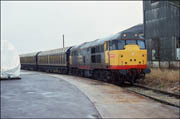
The first photograph, taken on 4 March 1989 shows 31247 standing in the Akeman Street depot while the cargowagons were unloaded. This was done using a forklift truck, the load being either carried on wooded pallets or in large "bags" with handles
suitable for this mode of handling. Class 31 was the normal motive power at this time, although 47s did appear from time to time. The management of the site were always welcoming to enthusiasts provided that a request was made before entering the loading
area so that the workers could be made aware that people were going to be present on site. The train did not run every Saturday and it was my practice to make a telephone call to the office on Friday afternoon to ascertain if there was a working the next
day if a trip was planned.
_4389.jpg)
This picture, taken a few minutes after the one above, shows 31247 about to move the train towards the headshunt before leaving the site and heading to Aylesbury to run round. As there was no loop provided at Akeman Street, the first part of the journey was achieved with the locomotive propelling the train to
Grendon Underwood Junction from where it would head engine first to Aylesbury.
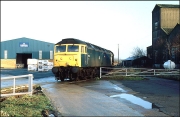
As I mentioned above, a class 47 did occasionally turn up at Akeman Street. I was told at the time that the train, which originated at Ince & Elton on a Friday, usually carried traffic for the Horsham depot of Kemira. If this was the case then the Akeman Street portion was dropped at Bletchley for one of the local class 31s
to work the following day. If there was no Horsham traffic for any reason then the class 47 remained on the train and worked to Akeman Street itself. On 5 January 1991, this appeared to be the case and 47146 is seen in a welcome patch of sun waiting for the wagons to be unloaded.
The temptation to take too many pictures in this sort of location is sometimes overwhelming especially as there is always the chance that the traffic may cease at any time with little notice.
This image of 31420 from 11 November 1989 shows the train immediately before it left Akeman Street depot with the 2nd half of the train and was taken with permission from the trackside just before the whole consist
was joined together for the journey to Grendon Underwood Junction.
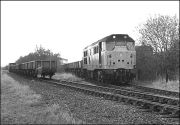
This picture shows 31420 re-marshalling the train which had been split to facilitate unloading. The first half is standing on the branch to Grendon Underwood Junction while the loco is bringing the remaining
wagons out of the headshunt. On this occasion, 11 November 1989, the load was not palletised and the bags of fertiliser were individually lifted out by forklift truck.
The short section of line from Akeman Street to Grendon Underwood Junction was not especially photogenic. This view, taken from a road bridge towards the beginning of the branch was about the best available. 31247 is seen here propelling the train towards the junction, where it will reverse and head south to Aylesbury. The brake van at the front can just be discerned
through the mist and light drizzle on 4 March 1989.
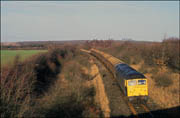
In somewhat better light to that seen in the photograph above, 47146 has just about arrived at Grendon Underwood Junction on 5 January 1991 while propelling its train of empty cargowagons from Akeman Street fertiliser depot. The bridge on which I was standing was situated on a bridlepath and subsequently collapsed to be replaced with a boarded crossing.
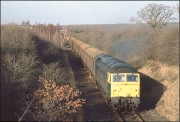
A few minutes later, the train has joined the Claydon Junction to Aylesbury main line and is heading south to Aylesbury in order to run-round before returning north. Worthy of note are the chimneys of the London Brick Company at Calvert. Bricks were still being manufactured here at the time and it was always a welcome sight to see the chimneys on the horizon
as one approached the turn for Calvert from the Bicester to Aylesbury road. The smell of the clay being baked was equally memorable and it is debatable whether this smell was preferable to that coming from the landfill site. My plan was to photograph the return from Aylesbury from the bridge just about visible in the far background. The easiest access was to
walk down the Akeman Street branch, which I did. Just as the train came into view a huge black cloud appeared along with torrential rain. The light completely disappeared and even the black & white negative was so thin as to be unprintable.
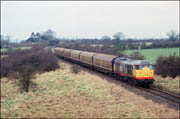
On 4 March 1989, 31247 is seen approaching Quainton Road station with the Akeman Street train while en-route to Aylesbury where the loco will run-round the wagons before heading north to Calvert, Claydon L&NE and the Bletchley Flyover. Once again, the weather was very poor but this section of line had a 20mph speed limit so stopping the action
was not too much of a problem.
A couple of miles to the south of Quainton Road are the remains of Waddesdon Manor station. This, being situated pretty much in uninhabited countryside, was built largely for the use of the wealthy owners of the nearby eponymous country house.
31420 is seen passing the site remains of the down platform on a very dull 11 November 1989 while heading north from Aylesbury after running round its train.
_quant_121188.jpg)
Once the locomotive had run-round the wagons in Aylesbury station the train returned north. On 12 November 1988 it is seen in some most uncharacteristic sun, albeit rather weak and peeping through the remnants of some dense early morning fog while passing through Quainton Road station behind 47422.
This scene has dramatically changed, unusually for the better, following the expansion of the Buckinghamshire Railway Centre. This is well worth a visit, even on non-running days, and the staff there always make visiting enthusiasts very welcome.
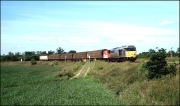
The sun did occasionally appear during these outings, as witnessed by this shot of 31555 rounding the curve from Calvert at Claydon L&NE Junction on 29 June 1991. This train is ideal for this location, bearing in mind the very tight curvature of the track - the Avon Binliner is too
long and the end of the train is lost out of the frame. Mick, the owner of the land upon which I was standing, was always amenable to me using the field as long as permission was sought in advance. Quite rightly, he did not like people traipsing over his property without so much as a "by your leave"
and I saw (and heard) an enthusiast being given very short shrift on one occasion when he just parked his car in the farmyard and marched over the field as if he owned it.
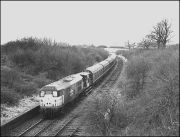
To the north of Claydon Junction lay Verney Junction where the lines for Cambridge and Buckingham left the Bletchley line. Platform edging is the only sign that any railway infrastructure was ever present here. In this, another shot from the overcast
4 March 1989, 31247 is heading north on the former southbound tracks with the empties from Akeman Street. It was a feature of this line that the best parts of either line were used when the route was singled and there are several instances of track slewing to demonstrate how this was done.
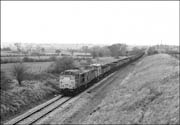
This view of 31420 shows the empty fertiliser wagons from Akeman Street approaching the former station at Winslow on 11 November 1989. An example of the track slewing I mentioned above can be seen here. A view of the remains of Winslow station appears further on in this section of the website.
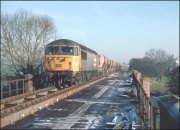
The first shot in this part of the section dealing with stone traffic shows a morning empty stone train, 6V11 from Wolverton to Whatley, behind 56038 on a cold, frosty and bright 17 January 1989. The location is on a bridge over the River Reay near Islip on the former double track section which of course has now, in 2020, been re-double and is a busy
main line with frequent passenger trains.
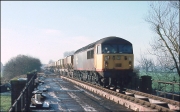
Not longer after 6V11 shown above had cleared Oxford North Junction the loaded train from Whatley, 6M49, appeared behind 56049. The track had not long been singled at the date of this photograph, 17 January 1989. had not long been singled and it appears that the main baulks of timber supporting the remaining track had been renewed. The remaining track was slewed from side to side at various points along the route to take advantage
of the sections in better condition and this was obvious at many points along the line.
In much worse weather than the two shots above, on 27 October 1987, this one shows 56030 in charge of 6V11 passing Claydon Junction on the main line. The signal towards the back of the train controls the junction to Calvert and Aylesbury
and this short section of double track enables run-rounds of traffic from that line to take place. The signal panel hut and the relay cabin can just about be made out in the background; the fog and rain generator in the latter working at full
power on this occasion!
The conditions at Claydon Junction on 18 March 1989 were a little better than in the picture of 56030 shown above as 56040, again with 6V11, passes the exit from the loop. This photograph was taken from the bridge just about visible from the
previous view. This spot currently marks the end of the line although plans are in place for the line to be reopened to Bletchley and then on to Cambridge to provide a link between the country's principal university cities and hopefully
provide an alernative to the overcrowded road system, especially towards Cambridge.
This is a Saturday morning shot of the Whatley to Wolverton loaded stone train, 6M24, passing the site of Swanbourne station on 29 June 1991. This section of line was on a rising gradient for loaded trains and the sound of the 56 was audible for several minutes before the train came into view. I remember this shot well, as I
was in considerable pain from my back, which had "gone" as I lifted my tripod from the car boot but I did achieve the shot, one of my relatively few in sunshine on this section of the Oxford to Bletchley line.
The former coal concentration depot at Aylesbury saw regular stone trains from Mountsorrel in the early 1990s. These conveniently ran on Saturdays and this picture, taken on 3 March 1991 shows 56062 at the exit of the depot as the shunter prepares to oversee the train pulling forward to allow the last wagons to be unloaded.
The driver was on the other side of 56062 and about to climb into the cab.
The train arrived here from the Calvert direction, to the left of this scene, and had to be propelled into the sidings for unloading. This, in common with the Akeman Street train shown earlier in this section, meant that a brake van had to be included
in the consist; an unusual sight on what was to all intents and purposes a block train of aggregates.
In view of the rarity value here is a picture of the brake van on the back of the Aylesbury to Mountsorrel empty Redland stone hoppers on 17 February 1990. Also visible are a few Network South East DMMUs on the left and some permament way wagons loaded with spoil and sleepers on the other side under the lineside trees.
My main interest in 1990 was black and white photography and the processing and printing of the films in my own darkroom but I usually carried another camera loaded with colour transparency film.
On 17 February 1990 the sun appeared at Aylesbury as 56061 stood outside Aylesbury as the train, empty stone hoppers bound for Mountsorrel,
waited for a path into the station so that the locomotive could run-round its wagons.
The Mountsorrel to Aylesbury stone train seemed to have an affinity for 56061 as it appeared again on 3 March 1991. This time I photographed it as the train approached Aylesbury station on the goods line/long siding from the terminal prior to the locomotive running round the hoppers. 645
A 20mph speed limit was imposed on the line from Aylesbury to Claydon Junction and Bletchley which did allow for a fair amount of chasing by road to get plenty of shots. After 56061 and the empty Redland stone hoppers from Aylesbury to Mountsorrel had left the former a cross-country drive was made to near the site
of Winslow station where the sun just began to appear from some thick cloud at precisely the wrong moment.
The next photopgraph of 56061 on 17 February 1990 was as the Aylesbury to Mountsorrel empty hoppers passed Quainton Road station. This preservatiion site is unusual as an operational freight line bisects the site meaning that 2 entirely unconnected
railway systems have to be managed by the operators.
My final shot of 56061 on 17 February 1990 was as the Redland hoppers en-route to Mountsorrel from Aylesbury went past the island platform at the former Calvert station. The rubbish containers from the Northolt train are on one of the
unloading lines at the landfill site. The locomotive that had brought in the loaded containers had already taken an empty rake back to the capital leaving its inward train to be moved by a conveyor system involving chains or cables and a powerful
fixed winch.
In the 1980s and 90s there was an extensive network of coal trains around the country with various hubs despatching loads to local yards. Aylesbury was one such destination and I did go
over once when someone told me that it was running; not always to ascertain in the days before mobile communications. I can't find the visit in my scrappy notes and but the negative sheet
was filed in my 1989/90 folder. I didn't take any colour images that day and the following black & white shots sum up the trip. The first one shows 37308 shortly after leaving the yard with 4 HTAs, one of which
is still loaded and may well have been destined for another location.
After unloading the train went up through Aylesbury station to the sidings where 37308 ran round the hoppers before going back to Didcot via Claydon Junction and Bicester
London Road. This shot shows the train entering Aylesbury with plenty of proper railway infrastructure on view which in 2020 has long since been replaced with more modern
but much less atmospheric equipment.
There was time for a walk to the bridge on the other side of Aylesbury station to take this picture of 37308 waiting for the road to Didcot via Claydon Junction. There wouldn't have been
much in the way of conflicting traffic at this date as passenger trains went no further; Aylesbury Parkway was many years in the future and had probably not even been thought of at this stage.
Within a few years 37308 had been repainted into BR blue livery making it an immediate "must have" for photographers despite it having carried the colour scheme for years
and almost certainly ignored because of it!
There was some disruption to fuel oil deliveries by road to some railway fuelling depots in February 2001 and the one at Aylesbury had a special trainload to ensure that the Chiltern
depot did not run short. On Saturday 24th the empty oil tanks were said to be removed although the locomotive allocation was unknown to me until part way through the journey when
a friend in the area called to let me know. It turned out that the expected class 66 would not materialise and the more interesting 37065 was there doing the shunting. This first image was taken
as the train was facing south in the platform prior to being uncoupled and run-round the tanks to point everything in the right direction.
In this shot from the bridge at the north end of Aylesbury station on 24 February 2001 37065 has been coupled to its train after a shunting move and run-round and will soon move the whole lot into platform 2 ready for departure
towards the sidings to the north of the station, as seen in this earlier view of 37308, for another run-round before final departure.
Here is 37065 at Aylesbury on 24 February 2001 as it leaves the station for its final run-round of the day in the sidings on the then non-passenger line to the north of the station.
There was plenty of time to head south for the last shot of 37065 on 24 February 2001 as it went towards London with the empty oil tanks from Aylesbury depot. Some local
friends were on the scene and led us to a spot in Little Kimble where the owner of an Indian restaurant kindly allowed us to use his car park to avoid too much of a walk.
We heard the train coming before everything went quiet for several minutes: almost as if the locomotive had failed. It soon went (very) noisy again
and the consensus was that the driver had stopped in a convenient spot for a photograph! He was clearly enthusiastic, to say the least, and this picture doesn't do justice
to the scene on the day. I have some video and hope to have this digitally transferred in the near future so that it, and many other similarly noisy bits, can be viewed again.
The army depot at Bicester COD used to have regular winter deliveries of coal used to fuel the boilers heating the buildings all over the complex. These ran on Saturday mornings when neither the MOD stores train or the Calvert to Bath and Bristol
binliner ran meaning that paths were availablein both directions between the 2 hourly passenger shuttles to Bicester London road station. If, as was often the case in 1994, there was no information
about whether or not any particular train was running my habit for this working was to go to Hatton first. This potentially saved a lot of time and petrol and if the train turned up there was plenty of time to get to Bicester while it
went to Didcot to run around and reverse. On 22 January 1994 56129 appeared on the curve adjacent to Hatton station with one of the usual rake of HTAs. Hatton is convenient for the M40 and a gentle run to Bicester
Oxford Road bridge was made arriving in plenty time to see 56129 coming out of the sun in quite challenging lighting conditions. The colour shot was rubbish but the black and white is, I think, quite dramatic.
There wasn't any particular class of locomotive allocated to the Toton to Bicester coal traffic and on 8 January 1994 58038 was in charge of the HTAs. As usual I went to Hatton first to ascertain if it was running and took this shot
as it approached the station. By the time I reached Bicester some cloud had arrived but this wasn't a problem as the train was stationary when the shutter was pressed. The train crossed over to the siding, formerly the up line, at the pointwork in the background and was then
propelled into the COD depot. The empty wagons from the previous working were collected and taken back later the same day - quite often MUCH later so I never did hang around and take a shot of it. I regret that now...
The Toton to Bicester coal train ran again on 12 February 1994 this time with 56058 providing the power. I knew in advance that it was running and as it was an exceptionally dull morning I went to a crossing at Langford Lane just to the Oxford side of Bicester COD where a shot in the sun wouldn't
be worth the effort. The train came at just about the booked time and this occasion a nearly square format cropped from the scan of my 645 negative seemed better than either a vertical or landscape view.
In early 2000 the originating point for the Bicester coal was Daw Mill colliery and it was usual then for the train, 6V46, to run to Didcot on the Friday before going to Bicester the following day. On Friday 3 March 2000 I was at Hatton for a northbound working when 37714 came south
with the HTAs en-route to Didcot. This caught me on the hop and the composition suffered accordingly. On the Saturday morning I went to Bicester and was surprised to see 47640 arrive with the loaded hoppers and can only assume that the 37 had either failed or was required elsewhere. The locomotive was scheduled
to leave Bicester light engine but I found out over the course of the next week that it had picked up a rake of stone hoppers from Bicester and taken them off to, initially at least, Didcot...
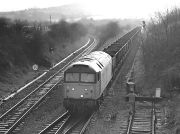
Another branch that received regular coal traffic in the 1980s was the line from Princes Risborough to the cement works at Chinnor. The coal originated from either Toton or South Wales but this traffic came to an end in December 1989 when it was adjudged uneconomic either to
refurbish the elderly hoppers used on this flow or to provide new facilities at the almost life-expired terminal. The final loaded train ran from Alexandra Dock Junction, Newport on 20 December and was in the hands of 47258. It is seen here arriving out of the mid-day sun at Princes Risborough where the shunter,
leaning on the buffer-stop, will be picked for the run down the branch.
_201289.jpg)
Whilst at Princes Risborough a headboard was attached to the locomotive by members of the local Railway Society before it joined the branch. I've never liked headboards of freight trains and this was inaccurate inasmuch as the actual final train on the branch was when the empty coal wagons were picked up a few days later. It is pictured here approaching the crossing at Bledlow in rapidly deteriorating light.
The weather was poor all day and although I did take a few colour slides for the record the black and white images were much better. This one shows 47258 approaching the conveniently placed road bridge which overlooked the cement works in one direction and a tree-lined cutting between housing estates
looking towards Princes Risborough.
_201289.jpg)
The shunter had to leave the warm and dry cab of 47258 to perform his duties and is clinging to the door-rail before dismounting to do his stuff with the wagons. The lack of a hard hat would give today's Health & Safety monkeys an
a fit!
_201289.jpg)
The train is seen here shunting the coal hoppers into one of the remaining sidings prior to the rake of hoppers being split prior to unloading.
Enthusiasts pay close attention to 47258 and its train of hoppers as the brake on the leading wagon is released in order to allow the consist to be propelled into one of the unloading roads at the cement works.
In this view, the first half of the train can be discerned in the siding alongside the cementworks whilst the remaining hoppers are shunted out ready to be propelled into an adjacent siding. One of the elder statesmen of British railway photography is visible in the picture as Brian Morrison, on the left, approaches the camera.
_201289.jpg)
A decent view of the train, run-round loop, cement works and the assembled throng of enthusiasts was available from the bridge adjacent to the works. The train is seen here being shunted prior to being split ready for unloading. The conditions were dreadful but at least the headboard
was on the other end of the locomotive.
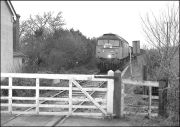
Once the loaded hoppers had been shunted in the appropriate sidings, the empty rake from the previous train was taken away. In the very last glimmer of light, 47258 is seen approaching the crossing gates at Bledlow en route to Rrinces Risborough and thence Newport ADJ. A cab-ride video was
produced of this working and one of my very few claims to fame is that I appear on this tape on the return of the slip-worked empties at Bledlow, agreeing to close the crossing gates after the train to save the second man a long
walk back to the locomotive.
_291289.jpg)
In this, the final picture of this sequence, 47258 is heading over the crosssing at Bledlow, the second man having climbed back into the cab. So ended a most enjoyable afternoon's photography, tinged with sadness that yet another branchline closed to freight traffic.
The road bridge at Banbury Road, Oxford was a convenient place to photograph a southbound train from the Bicester direction and in 1999 gave a view of the A34 which then was relatively quiet compared to the nose-to-tail encountered in 2020.
This picture shows 37701 heading towards Didcot, the then hub for MOD traffic from Bicester, Kineton, Ludgershall and other locations on the former Southern Region. The train didn't run every day and loadings were variable, ranging from nothing
to very long trains of mixed types of wagons.645
Due to engineering work on the Bicester to Oxford line in September 2003, the MOD train from Didcot to Bicester was retimed and diverted. It ran via the Hanwell Loop, Princes Risborough, Aylesbury and Claydon LN&E loop. I pictured it passing Quainton Road station top and tailed by 66060 and 66054 on 4 September.
The topped and tailed consist was in place in order to avoid time-consuming 2 run-round moves at Claydon Loop. 645
Here is a later view of the Didcot to Bicester COD train taken on 7 May 2013. I was at Mill Lane near Islip to photograph 56303 on its train from the Calvert landfill site and decided to hang on for a few minutes to take a shot of 66124 on 6A49.
This train can be a bit of lottery as far as loading and even running at all is concerned as it sometimes has just one wagon, sometimes none at all and as on this occasion a reasonably long set of flats and ferrywagons. The red light warning
road users to wait before opening the gates can just be seen on the left of the gates and I was pleased to get a few shots here before the crossing was permanently closed and the scene changed for ever when the
line is doubled for a much more intensive passenger service from Oxford.